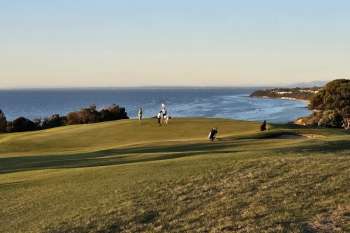Following last month’s introduction and the beginning of our architectural countdown, comes the final five in our listing of the greatest ever golf course designers. This elite group includes three from the heady days of the early 1900s and two modern heavyweights in Tom Doak and Bill Coore. While some will no doubt suggest that you can’t compare active architects with the greats of yesteryear, I assert that both Doak and Coore have already established a portfolio of global significance. If neither man were to build another golf course they would still be regarded among the best designers in the history of our game.
So onto the final five and, as outlined last month, the criteria here was to simply look at the quality of various design portfolios and determine which were the most outstanding. At number 5 is Donald Ross, the most prolific pre-war architect in the United States.
5. Donald Ross – Though he grew up on the Scottish links of Dornoch, and was an accomplished player, Donald Ross’s decorated career in golf really began in earnest when he sailed for Massachusetts in 1899 to take up a role at Boston’s Oakley Golf Club. Ross arrived as a clubmaker, greenkeeper and golf professional, but would soon make his name as a course designer, moving south to Pinehurst the following year and designing more than 400 courses from his base in the North Carolina resort town.
Although he was responsible for creating some of the world’s most famous tournament venues, like A.W. Tillinghast much of Ross’s best work has been radically altered. Oak Hill, Oakland Hills, Inverness and Interlachen have all hosted major championships, yet because of trees, increased roughs, narrowed fairways and stretched tees none looks or plays as Ross had intended. Even the layout most synonymous with Donald Ross, his beloved No. 2 course at Pinehurst, has changed over the years with more formal bunkering, the loss of native sandy wastes and greens that are both quicker and more crowned that originally planned.
Ross’s greatest strength was routing courses across decent ground. He used fairway movement and inverted greens beautifully, often positioning these targets atop gentle crests but without his designs feeling overly formulaic or repetitive. In order to best appreciate his considerable talents, golfers are encouraged to seek out some of his lesser known projects, courses like White Bear Yacht Club, Essex County Club, Plainfield, Wannamoisett and Teugega, all charming layouts that have survived the decades with their core largely intact. Alternatively, well-connected players can visit the storied Seminole layout in southeast Florida, a particular favourite of Ben Hogan.
Donald Ross is a really interesting design character, he worked on some wonderful pieces of land and his best holes are extraordinary, but there are too many diminished Ross courses out there to get a really accurate sense of just where he sits in relation to other architects from this era. I don’t rate him as highly as some other commentators, though I do suspect that had we compiled this list back in the 1950s he might have challenged for top spot.
4. Tom Doak - Tom Doak was always destined to be an architect of note. From a young age golf design was his passion and his study of the world’s greatest courses, his apprenticeship with Pete Dye and his publications on a range of architectural subjects were all part of a carefully constructed plan to establish his credentials and position himself as modern golf’s Renaissance man. Some regard Doak’s writing as controversial, but his views are well formed and credible, and, importantly, he has been able to back up his commentary with quality design work. He is currently the hottest architect in golf, having produced as many world-class courses over the past ten years as MacKenzie during the 1920s.
It all started with Pacific Dunes in 2001 at the Bandon Dunes Resort, followed shortly after by Cape Kidnappers, Barnbougle Dunes, Ballyneal, Sebonack and Old Macdonald (also part of the Bandon Dunes Resort), each of which belongs among the world’s top 50 or 60 courses. When you factor in other hits like St Andrews Beach, the Rock Creek Cattle course in Montana, Stone Eagle in Palm Springs, Lost Dunes in Michigan and Stonewall near Philadelphia, you start to appreciate just how good this guy really is. Apart from new course projects, Doak has also done sterling redesign work on some of the world’s premier classic courses including MacKenzie’s beloved Pasatiempo and Raynor jewels like Yeamans Hall, Shoreacres and Camargo Club.
3. Bill Coore - Here in Australia Bill Coore is not yet widely known, but this softly spoken and unpretentious Texan is the man principally responsible for the creation of Sand Hills in the remote American dunes of Nebraska, regarded by most good judges as the best, and most influential, golf course of the past half-century. Like Doak, Coore got his start in the design business working for Pete Dye, where he learnt both the art of design and the craft of physically building features. After spending nearly ten years under Dye’s tutelage he established his own company and soon joined forces with fellow Texan, and dual Masters champion, Ben Crenshaw, creating the world regarded firm of Coore & Crenshaw.
Both Bill Coore and Ben Crenshaw are ardent devotees of classic golf course design and passionate about the ingredients that make up great golf. For Coore this means working closely with the land and building green, bunker and fairway shapes that not only allow for strategic play, but also appear to be completely untouched by man. This is a philosophy that most modern designers claim to embrace, but few are able to physically build courses that look or play as naturally as Bill Coore. Aside from Sand Hills, Coore has also created other world-class jewels including Friar’s Head, Old Sandwich, Kapalua (Plantation), Colorado Golf Club and Bandon Trails.
Perhaps even more impressive are Coore’s courses on softer ground and/or with modest budgets. The likes of Golf du Medoc in France and East Hampton, Hidden Creek and Chechessee Creek in America are unlikely to win international accolades, but each is almost perfect for the property it’s built upon, and completely original and charming at the same time.
The exciting thing for Australian golfers is that later this year our first Bill Coore course will open, when Lost Farm at Barnbougle Dunes is completed. It’s unlikely that Lost Farm, or any subsequent course for that matter, will quite match the standards set at Sand Hills, but this will be wonderful golf and we should all be grateful to Barnbougle developer Richard Sattler for convincing Coore to travel from Texas to Tasmania to show us all what he is capable of.
2. Dr Alister MacKenzie – Australian golfers have long admired the work of Alister MacKenzie, who only spent a few weeks here in 1926 but influenced design in this country for decades to come. Aside from his brilliant work at Royal Melbourne, and the bunkering schemes planned for Victoria and Kingston Heath, he also played a significant role in the layout of Royal Adelaide and New South Wales, which each retain elements of MacKenzie’s plan.
More significant, however, are his best courses abroad. Cypress Point is arguably the most spectacular course in the world, and aside from a wonderful routing through the dunes, the pines and onto the Monterey coastline, it’s the quality of individual holes like 8, 9, 13, 15, 16 and 17 and MacKenzie’s naturalistic bunkering and dramatic green complexes that really stand out here.
He was, of course, also the original designer of Augusta National, which has changed structurally and strategically since MacKenzie’s final site visit in 1933 but remains an inspired place for golf. Most of the best bits at Augusta were conceived by MacKenzie.
Other notable MacKenzie works include Crystal Downs in Michigan, Pasatiempo in California and Alwoodly in England but there are many more as well.
MacKenzie remains golf’s most revered architectural figure and is also most people’s choice as the greatest designer of all time. His finest few courses are superior to any other architects and the genius of his best individual holes, such as 13 at Augusta and Lahinch, 15 at Kingston Heath, 11 and 16 at Pasatiempo, 10 at Moortown, 3 at Royal Adelaide and a number at Royal Melbourne, Cypress Point and Crystal Downs, is unsurpassed and evident to all who play them. Despite this sterling portfolio and a global reputation as golf’s greatest, there is one man who, at the very least, can match MacKenzie brilliant hole for brilliant hole – his mentor and one-time business partner Harry Colt.
1. Harry Colt - An all-round sportsman and accomplished amateur golfer, Harry Colt was a successful lawyer in 1894 when he walked away from the profession to help establish, design and then manage the Rye Golf Club in the south of England. A few years later he moved to the Sunningdale Golf Club in London’s Heathland, his role as club Secretary included the overseeing of changes to the original Willie Park Jr course, in response to the introduction of the rubber-cored ball. While at the club he also designed the remarkable Swinley Forest course nearby, and was sent north to Leeds to consult with founding members at the Alwoodley Golf Club. One of the members was a local doctor named Alister MacKenzie, who impressed Colt with his own design plans for Alwoodley and later became a partner in his flourishing business.
Although personality wise MacKenzie and Colt were diametrically opposed, they shared similar views on golf design. MacKenzie’s style was clearly more artistic but strategically they arranged their holes in much the same manner. Colt’s ability to ‘find’ exceptional par threes and his use of strategic, rather than panel, fairway bunkering were keys. A comparison between the two men is always interesting. If you limit the judgement to the best four or five courses then MacKenzie probably wins every time, but if you expand the criteria to include their complete portfolios then it’s hard to argue that anyone in golf rivals Harry Colt.
Colt didn’t design Pine Valley but he consulted with developer George Crump and helped him solve a complicated routing puzzle by creating the genius 5th hole. Likewise at Royal County Down, one of the most exciting courses in the world, a flawed layout was improved when Colt created the brilliant 4th and 9th holes, among other changes. Similarly, he wasn’t the sole designer of Muirfield, Rye, Royal Porthcawl, Woodhall Spa, Ganton, Royal Lytham & St Annes or Royal Liverpool but his input was significant. Other gems like Royal Portrush (Dunluce), St George’s Hill, Swinley Forest, Sunningdale (New), Hamburger, Kennemer, County Sligo, Wentworth (West) and Toronto Golf Club are pure Colt. As are fine secondary tier courses that often escape attention, such as the Eden Course at St Andrews, Royal Zoute in Belgium, Le Touquet in France, Frankfurter in Germany, Hamilton in Canada and Burnham & Berrow and Royal Worlington & Newmarket in England, the latter quite possibly the finest nine-hole course anywhere on earth.
As a disciple of the design philosophies of Dr. Alister MacKenzie, not to mention an enormous fan of his finest courses, I never expected to uncover a peer architect with a résumé of comparable quality, but Colt’s output during a 40-year career was truly extraordinary. While we can debate which man was the best of all time, what’s clear is that these guys not only built the most world-class golf holes they also made the most profound impression on generations of subsequent course creators.
What’s exciting for the modern game is that Bill Coore and Tom Doak stand on the brink of matching MacKenzie and Colt in terms of the number of first-class courses they have created. The fact that Australian golfers will soon be able to experience layouts from both these modern masters at one small Tasmanian resort is incredible.




